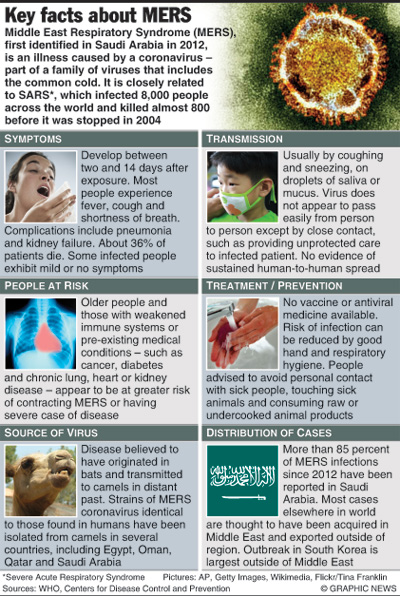Sunday Times 2
MERS virus spreads: Why it’s so difficult to fight
It’s starting to feel like the year of infectious diseases. Just as Ebola is winding down in West Africa, another potentially fatal illness has jumped from the Middle East to South Korea and China, spreading fears of a global pandemic. The Middle East respiratory syndrome coronavirus-commonly known as MERS-has killed nearly 40% of the 1,179 people it’s sickened since emerging in Jordan in 2012. Many more people may have unknowingly had less serious bouts of the disease, which is believed to spread from bats to camels to people.

Tourists wearing a mask to avoid contracting MERS as they tour a shopping district in central Seoul, South Korea on Friday. Reuters.
Key questions and answers about MERS:
How is MERS spread?
So far, the respiratory virus has had a hard time spreading from person to person. Most of its victims had direct contact with camels, or caught the virus in a healthcare facility that was caring for a MERS patient.
Theoretically, it should be easy to stop person-to-person transmissions by wearing masks and washing hands. But MERS spread at a dialysis clinic in Saudi Arabia last year and more recently at a clinic and hospital in South Korea, where a man who returned from Saudi Arabia two weeks ago spread the virus to 34 others. One of those exposed in South Korea traveled to China, flying and riding a bus while likely contagious. It’s not yet clear whether that man passed the virus on.
What are the symptoms of MERS?
MERS can cause fever, cough, shortness of breath, diarrhea, body aches, nausea and, in the most serious cases, pneumonia and kidney failure, according to the U.S. Centers for Disease Control and Prevention. Its incubation period is usually 5 or 6 days, but people can be contagious for up to 14.
The virus kills by causing respiratory or kidney failure, or septic shock, an infection that overwhelms the body’s defenses.
Who’s most at risk?
Those most vulnerable to dying from MERS appear to be men over 50 with a preexisting medical condition, including kidney or lung disease, diabetes, or cancer treatments that reduce immunity, according to the World Health Organisation.
How is MERS treated?
Although MERS has now been known for more than three years, there are no specific vaccines or treatments for it. The sickest patients are placed in intensive care and treated according to their symptoms.
In South Korea, officials acted quickly to contain the disease’s spread. Just as with Ebola in West Africa, the best way to control the virus is by identifying and isolating anyone who has been in contact with an infected person, says Darryl Falzarano, a research scientist at the Vaccine and Infectious Disease Organization, International Vaccine Center (VIDO-InterVAC) at the University of Saskatchewan in Canada.
This week, South Korea has quarantined more than 1,300 people and closed hundreds of schools to keep the virus from spreading further.
Is there any hope for a vaccine?
Daniel Lucey, a microbiologist and immunologist at Georgetown University Medical Center, says he’s aggravated by the lack of progress against MERS, especially because the virus is part of the same family as SARS, which caused global panic in 2003-2004 when it spread from China to Canada.
Over the last year, U.S. government researchers have managed to breed mice that are susceptible to MERS, making it feasible to test early drug candidates, says Vincent J. Munster, chief of the Virus Ecology Unit at the National Institute of Allergy and Infectious Diseases, who led the work. Others are testing possible antibodies to the virus and studying vaccine candidates, though none has yet been tried in people.
One key question surrounding the development of a vaccine is who should get it. Camels are a better target for vaccination than people, says Falzarano.
If you vaccinate people, he asks, “who do you vaccinate? Everyone in Saudi Arabia? The Middle East?” While a camel vaccine could be developed in about a year, a human vaccine likely wouldn’t make it to market before 2020 because of safety requirements. “Do we really know that MERS is still going to be a problem then?” Falzarano asks.
 How is MERS spread?
How is MERS spread?
As a respiratory disease, MERS can be spread through droplets coughed into the air. If they are breathed in or land on a surface that someone else touches, that person can contract the disease. A sick person with virus on their hands can also spread it. Casual contact, such as passing someone on the street, is not believed to risky, according to the CDC.
So far, it seems that MERS is mainly spread from camels to people; many of those who have fallen ill either take care of camels, have come into close contact with them, or consumed camel products like raw meat or unpasteurized milk.It’s not entirely clear how this most recent outbreak has been spreading, though it’s possible that whatever treatment MERS patients are receiving is contributing to the spread.
Where did MERS come from? Why is it spreading now?
MERS is a so-called zoonotic disease, meaning it jumps from animals to people, but no one knows how or when it made the leap.
Please turn on Page 9

